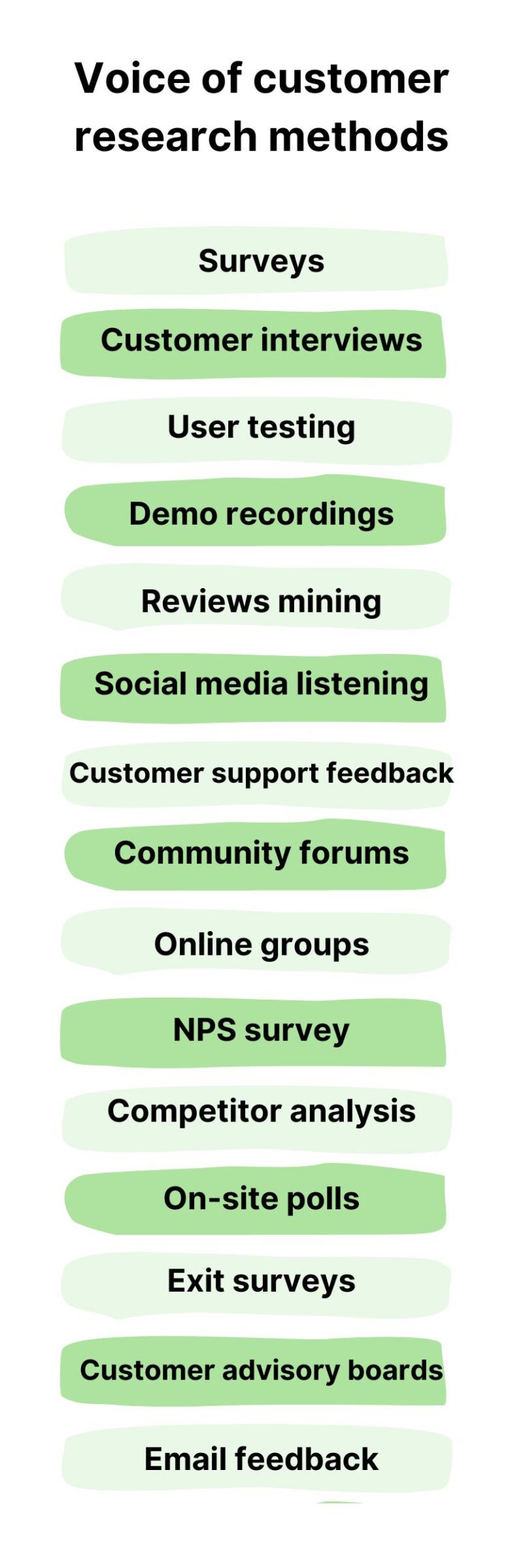In today’s customer-centric world, companies across industries invest heavily in collecting Voice of Customer (VoC) data to gain deeper insights into their audience’s preferences, pain points, and expectations.
Whether you’re a small business or a global enterprise, listening to your customers can improve your products, refine your services, and ultimately drive business growth.
But how can you collect this valuable information? In this blog, we’ll explore how businesses collect VoC data and why it is pivotal in shaping successful strategies.
What is the voice of the customer (VoC)?
Voice of Customer is feedback from leads, prospects, and customers on their needs, preferences, expectations, and experiences. It helps businesses understand what their buyers think about their products, services, or brands, allowing them to make more informed decisions that improve customer satisfaction and drive better results.
This feedback is collected in many ways including surveys, interviews, reviews, social media comments, or support interactions and is qualitative and quantitative. The qualitative data includes customer sentiments, opinions, and the specific language they use, while the quantitative data consists of measurable metrics like satisfaction scores or usage statistics.
By tapping into VOC data, business product management teams can identify pain points, areas for improvement, and the factors influencing customer decision-making when purchasing products and services. VOC also plays a crucial role in crafting more effective messaging using customers’ words and phrases. It helps bridge the gap between what businesses want to say and what customers want to hear.
Why collect VoC data
Collecting voice of customer data is essential because it provides direct insights into customer experiences, preferences, and pain points. It helps businesses tailor their offerings to more effectively meet customer needs and expectations without relying on hunches or guesses.
By listening to customers and addressing their concerns, businesses can improve customer satisfaction by demonstrating that they care about their experience. This builds trust and increases loyalty.
VOC data also allows businesses to craft more effective marketing messages by using their target audience’s exact language and motivations. This boosts engagement and conversion rates, as customers are more likely to respond to messaging that resonates with their real needs.
VOC data can be invaluable for identifying pain points and friction in the customer journey, as it reveals common challenges that customers face when interacting with your business. Businesses that use VoC data can enhance and personalize the experience across all touchpoints, whether in the sales process, onboarding, or support, to deliver a more seamless and consistent customer experience.
Another key advantage of VOC data is its role in driving innovation and gaining a competitive edge. Regularly collecting VOC insights helps businesses stay attuned to emerging trends and unmet needs.
Finally, VOC data plays a crucial role in aligning internal teams, such as marketing, sales, product development and customer support teams, by providing a clear, customer-focused understanding of what matters most to customers.
Voice of customer research
Amazon, for example, gathers VoC data through millions of customer reviews to fine-tune its product recommendations and improve the user experience. Marriott collects feedback via post-stay surveys to help them shape future services and offerings while Apple uses customer support interactions and feedback to guide product updates and feature enhancements.
There are many ways to collect customer feedback, and here are some must-consider techniques to incorporate into your customer journeys:
Surveys: Use surveys to gather feedback from your audience. For instance, if you’re writing for a webinar, survey past attendees about what they valued most or what prompted them to sign up.
Customer interviews: Conduct 5-7 interviews (about 30 minutes each) with customers. These provide deep insights into your audience’s needs and help craft tailored copy.
User testing: Run tests on platforms like usertesting.com to identify anxieties your website copy may introduce. This can also reveal issues on competitor sites.
Demo recordings: If available, review recorded product demos to identify patterns in prospect responses and areas of excitement to inform your copy.
Product review mining: Analyze product reviews (yours and competitors’) to understand why customers buy, their expectations, and their pain points.
Social media listening: Monitor social media platforms for mentions of your brand, products, or industry. Tools like Hootsuite or Sprout Social can help track customer discussions, complaints, and praise. This provides real-time insights into customer sentiment and emerging trends.
Customer support and feedback: Analyze support tickets, live chat transcripts, and feedback forms to understand common issues, questions, and suggestions. This can help identify pain points and areas where your product or service may need improvement.
Community forums and online groups: Engaging in online forums or industry-specific communities (e.g., Reddit, Quora, or niche groups) can reveal customer thoughts on topics related to your business. These discussions often highlight unfiltered opinions about products or challenges.
Net Promoter Score (NPS) surveys: Use NPS surveys to gauge customer loyalty and satisfaction. The feedback from NPS, especially the open-ended follow-up questions (e.g., “Why did you give us this score?”), can provide valuable insights into customer perceptions.
Competitor analysis: Study your competitors’ websites, marketing materials, and customer reviews to identify trends in how they communicate with their audience and what their customers value or complain about. This can help you position your messaging more effectively.
On-site polls and exit surveys: Use on-site tools like Hotjar or Qualaroo to place short polls or exit surveys on key pages. These can capture visitor insights as they engage with your website or when they leave without converting.
Customer advisory boards: Establish a group of loyal customers who provide regular feedback about your product or service. Their insights can guide future developments and improvements.
Email feedback: Send a follow-up email asking customers their thoughts after a transaction or interaction. Simple questions like “How was your experience?” can yield valuable feedback.
VoC research: Review mining
“Review mining” from platforms like G2, Capterra, Amazon and Yelp is a great way to gather customer insights on a product or service. The goal is to find out what drives people to seek solutions and understand their pain points and motivations. Here are some tips for review mining:
- Use various review sites to collect reviews of similar products or services.
- Focus on keywords or categories related to your business.
- Look for patterns, especially what people are tired of or dissatisfied with.
- Capture snippets of reviews using tools like Airstory or a spreadsheet.
- Read many reviews to collect enough insights.
- Organize VoC data to craft customer-centric messages based on their language.
By streamlining this process, you can quickly gather actionable insights and incorporate them into your marketing copy.
Best practices
Here are some best practices for an effective VoC program:
- Know what you want to achieve: Whether it’s improving customer satisfaction, reducing churn, or refining product features, set clear objectives to help focus customer feedback.
- Use a variety of channels: Rely on a mixture of methods, such as surveys, interviews, focus groups, social media, product reviews, support tickets, and direct conversations to gather both structured (surveys, NPS) and unstructured (open-ended feedback, reviews) customer insights.
- Assign ownership and accountability: Assign a team or cross-functional committee to manage the program, share insights and project manage actions.
- Segment your audience: Use industry, demographics, customer lifecycle stage, or product usage to divide your customer base and understand specific pain points and opportunities within each group.
- Align across departments: Ensure that you are not taxing or frustrating customers by having multiple departments request feedback. Coordinate with other departments to coordinate VoC initiatives. Don’t forget to share the results of your voice of customers campaigns with other teams so they can do their part to improve the customer experience.
- Ask questions that provide actionable insights: Focus on open-ended questions that give customers the freedom to express their thoughts but balance them with targeted, measurable ones like CSAT (Customer Satisfaction Score), NPS (Net Promoter Score), and CES (Customer Effort Score).
- Leverage technology: Use tools that allow for the collection of real-time feedback and data analysis.
- Analyze and use the data: Sift through the data to identify trends and issues and build action plans. If collecting large data, use tools like text analytics and sentiment analysis. Prioritize feedback that aligns with the program objectives.
- Follow up with customers: Let customers know how their input is used and your changes. This builds trust and increases engagement with your VoC program.
- Regularly review your program: Assess your feedback processes and adjust questions, tools, or channels based on evolving customer needs or business goals.
- Track key metrics: Measure metrics like customer satisfaction, retention, and engagement before and after changes to report on impact.
- Don’t fear negative feedback: Celebrate positive feedback and use negative feedback as opportunities for growth and improvement.
- Incorporate into strategic decisions: Ensure that the customer’s voice plays a role in product development, customer success strategies, and business decision-making at the executive level.
Voice of customer tools
Many tools in the market can help you gather customer feedback, such as surveys, analytics, and sentiment analysis. Here are some to consider:
- Qualtrics for surveys, feedback collection, customer sentiment analysis, and predictive intelligence to measure customer satisfaction and product experience.
- Medallia for real-time customer experience management, predictive analytics, and multi-channel feedback collection (email, social media, web) across all customer touchpoints.
- SurveyMonkey for customizable surveys, and product feedback.
- Clarabridge for analyzing customer conversations from email, social media, and surveys to understand customer emotions and issues.
- InMoment for feedback collection, social listening, text analytics, and predictive analyticsto enhance customer journeys and improving loyalty by identifying key drivers of satisfaction.
- HubSpot feedback tool for Net Promoter Score (NPS), customer satisfaction surveys, and customer effort scoreto measure and manage customer happiness from within your CRM.
- Zendesk for customer service ticketing, satisfaction surveys, and feedback management to track customer feedback during service interactions and improve customer support experience.
- CustomerGauge for NPS surveys, retention analysis, and revenue impact analysis to gather customer feedback.
- Usabilla (by SurveyMonkey) for website feedback, visual feedback, and surveys to collect in-the-moment feedback from website visitors to improve user experience.
- Hotjar for heatmaps, session recordings, on-site surveys, and user feedback to understand customer interactions with your website and gather direct user feedback.
- Trustpilot, G2, Yelp, SoftwareAdvice, GetApp, HomeStars, Capterra (Gartner) etc. for online reviews, reputation management, and customer insights.
Conversion copy with voice of customer
Most people write copy by typing a title and thinking about what they want to say. However, this approach can be a conversion killer.
What you’d like to say might have little to do with what your audience needs to hear. Good conversion copy starts by using the voice of customer data. It helps you understand their concerns and anxieties, what solutions they are attracted to, their decision-making criteria, what pushes them to say “yes,” and what holds them back.
The magic lies in borrowing your customers’ words and phrases so your copy resonates profoundly and addresses real needs.
Let’s talk to customers!
Are you looking to insert voice of customer methodologies into your workflows or analyze what customers and competitors say?
Let us help you connect with your customers!

